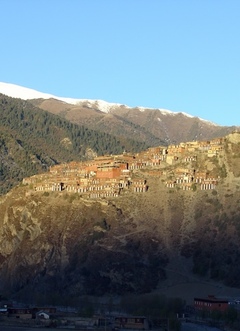History of Dzongsar Monastery
A History of Dzongsar Monastery
by Dilgo Khyentse Rinpoche
Generally speaking, there are four great valleys (shod chen) in Dokham: Kyishöd (skyi shod), Treshöd (tre shod), Meshöd (smad shod) and Tashöd (rta shod). Among these, in Meshöd, the second most important of the twenty-five glorious Sakya monasteries under the control of Derge is the one known as Dzongsar ('New Fortress'), so called because it was previously a fortress of the Beri King. According to Kongtrul Rinpoche, the site was originally a Kadampa settlement.
When Drogön Chögyal Pakpa of Sakya was returning to Tibet [from China] his party spent a day camped at Tratang in Meshöd. He saw the need to establish Sakya monastery at the site, and to that end offered an image of the Protector (i.e., Mahākāla) made from sandalwood, which was a support for his own meditative practice. This was clearly stated by Jamgön Khyentse Rinpoche. Chögyal Pakpa was active during the third calendrical cycle and we are now in the sixteenth, so that shows how many years have passed in the interim.[1]
The histories of the Ngari and Gangna lama residences (bla brang) are not entirely clear to me. The way in which the first Khyentse incarnation of the Dilgo family carried out his vast activities while residing in the monks' quarters is well known.
I do not know the full extent of all the sacred items at the monastery. Within Khyentse Rinpoche's residence the main images included a statue of the Buddha, Lord of Sages, from eastern India, which had been a support for the first Khyentse's personal practice; the sublime representation of the Guru known as Blazing Splendour of Attainments (dngos grub dpal 'bar), a joint treasure revelation of Chokling and Khyentse; four Guru representative images—one each for [the activities of] pacifying, enriching, magnetizing and wrathfully subjugating—signifying Khyentse Rinpoche's status as the fifth kingly treasure-revealer (after his passing the pacifying representative image went with Khyentse's sacred relics to the Palpung Lhasarkhang temple at Palpung Monastery, where it now remains; the enriching representative image is at Gönchen with the golden reliquary known as 'the Single Ornament of this World'; the magnetizing and wrathfully subjugating representative images were placed within Khyentse's reliquary stūpa and copper and gold statue at Dzongsar Monastery). There were also some dhaikshiṃ representative images[2] offered by Nyenchen Tanglha, as stated in the biography. I myself witnessed six or seven treasure caskets, both opened and unopened, including the treasure casket that contained an image of Jambhala taken from Dzam Pema Shelpuk.[3]
Among the yellow scrolls were two folios of yellow paper from the Khandro Sangdü[4] as well as several other folios from yellow scrolls.
Representatives of enlightened mind included a bronze five-spoked vajra, which was a mind support for the Assembled Sugatas of the Three Roots (rtsa gsum bde gshegs 'dus pa); the skull of the Nepali Vasudhara, revealed as a treasure by Chokgyur Lingpa; the skull of the dharma king Tri Song[detsen]; the maroon skull of Tsari offered by Shingkyong Kunga Shönnu;[5] a dagger (kīla) of meteoric iron offered by Kharak Dorje Khyungtsünma;[6] and a turquoise-coloured soul-stone (bla rdo) of Damchen Dorje Lekpa featuring a naturally arisen image of Damchen.
These are the objects that are clear in my mind. I don't now recall precisely the objects that came into the possession of Chökyi Lodrö Rinpoche, the second Jamgön Khyentse incarnation. I believe that the representations of enlightened body included more than fifty terma statues in bronze of various sizes and that there were around ten representations of enlightened mind, including vajras and kīlas.
I don't know what more to say. I could not clearly list all the successive Ngor khenpos at Dzongsar Monastery. This is all that is stored in my mind.
| Translated by Adam Pearcey, 2020.
Bibliography
Edition Used
bkra shis dpal 'byor. gsung 'bum/_rab gsal zla ba. BDRC W21809. 25 vols. Delhi: Shechen Publications, 1994. Vol. 4: 180a–181b
Secondary Sources
Diemberger, Hildegard. When a Woman Becomes a Religious Dynasty: The Samding Dorje Phagmo of Tibet. New York: Columbia University Press, 2007.
Dilgo Khyentse. Brilliant Moon: The Autobiography of Dilgo Khyentse. Trans. Ani Jinba Palmo. Boston & London. Shambhala Publications, 2008.
Jamgön Kongtrül. The Life of Jamyang Khyentsé Wangpo. Trans. Matthew Akester. Delhi: Shechen Publications, 2012. Revised online edition, Khyentse Foundation, 2020.
Version: 1.2-20231126
-
The sixteenth calendrical cycle ended in 1987. ↩
-
Original reads: dzhi kshiṃ. dhai kshim is a reddish coloured alloy used for statues. ↩
-
i.e., the Lotus Crystal Cave at the head of the Dzam valley. See The Life of Jamyang Khyentsé Wangpo p. 291, n. 240 ↩
-
i.e., the Gathering of All Secret Ḍākinīs (mkha' 'gro gsang ba kun 'dus), a rediscovered treasure originally revealed by Jomo Menmo (1248–1283). ↩
-
zhing skyong kun dga' gzhon nu, a protector deity. On the skull(s) of Tsari see Diemberger, When a Woman Becomes a Religious Dynasty: The Samding Dorje Phagmo of Tibet, pp. 97–98. ↩
-
A protector deity, also known as Dorje Drönma. See Brilliant Moon, p. 104. ↩
